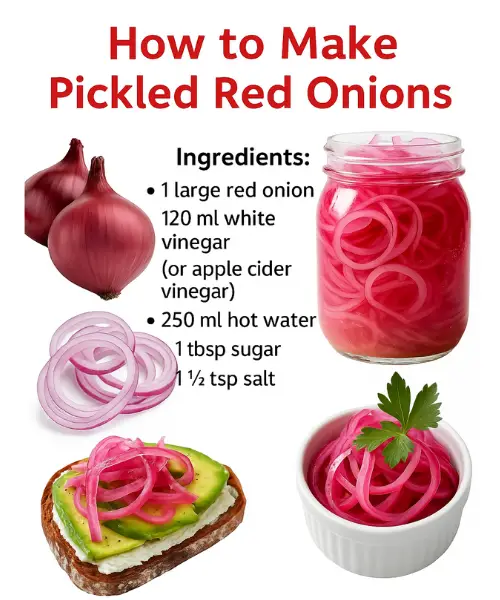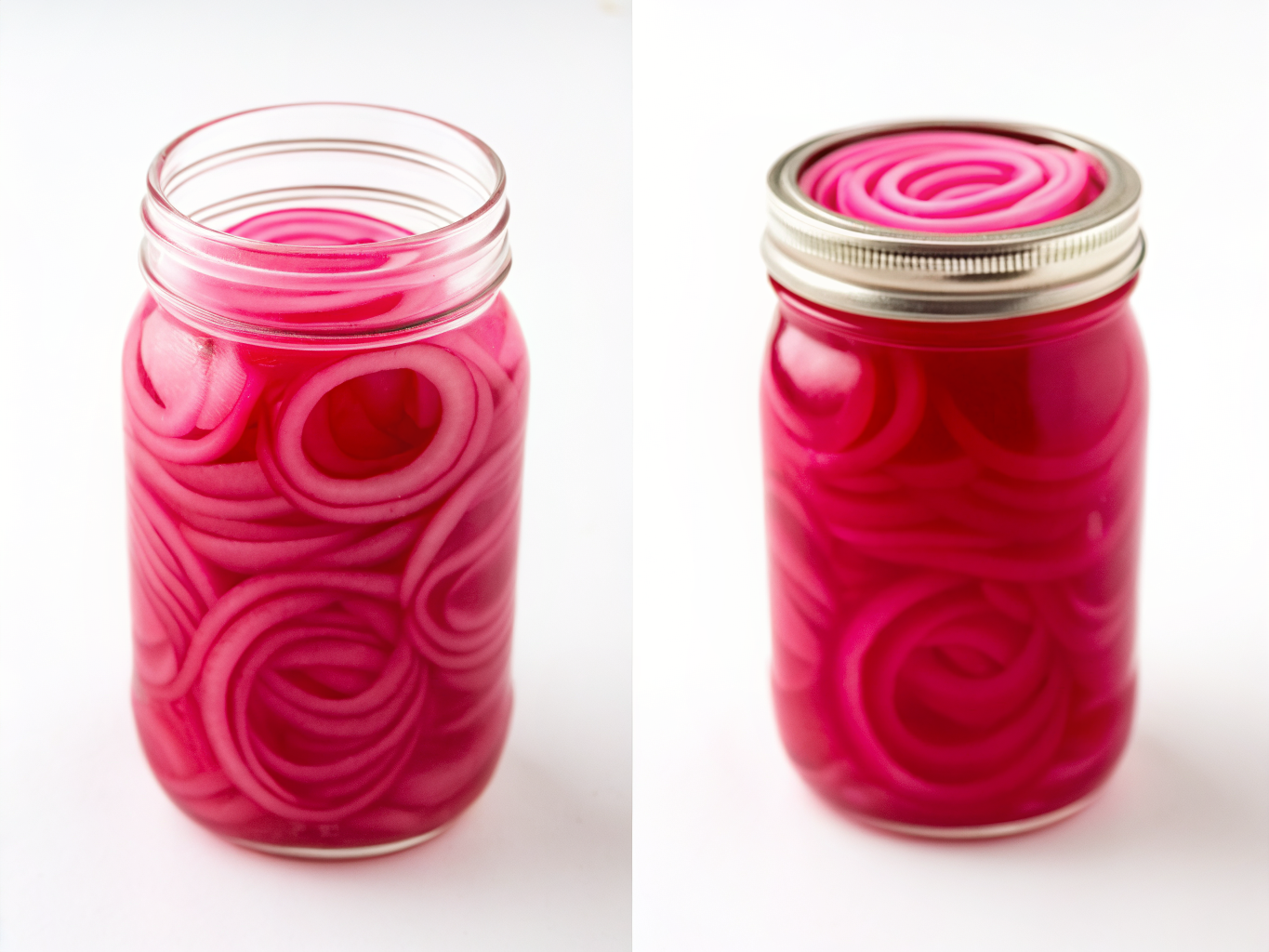Pickled Red Onions Recipe: A Complete Guide to Flavor, Preservation, and Creativity
Pickled Red Onions Recipe: A Complete Guide to Flavor, Preservation, and Creativity
Pickled red onions are one of those versatile condiments that can completely transform a dish. Their vibrant pink color, tangy-sweet flavor, and satisfying crunch make them a favorite addition to countless recipes around the world. From tacos and sandwiches to salads and grilled meats, pickled onions add brightness and depth without overpowering the main ingredients.
In this guide, you will learn not only how to prepare them easily at home but also the history behind pickling, variations to try, health benefits, serving ideas, storage tips, and answers to the most common questions. By the end, you will be able to make and enjoy your own jar of pickled red onions and incorporate them into your everyday cooking.
Why Pickled Red Onions Deserve a Place in Your Kitchen
The magic of pickled onions lies in their simplicity. With just five basic ingredients—onion, vinegar, water, sugar, and salt—you can create a condiment that adds complexity to any dish. Unlike raw onions, which can sometimes be harsh and pungent, pickled onions are mellowed by the vinegar and sugar, becoming tangy and slightly sweet. This balance makes them a perfect companion to rich or heavy foods like grilled meats, creamy cheeses, or fried dishes.
Another advantage is that pickled onions are incredibly quick to make. Unlike traditional fermentation, which can take weeks, these onions are ready in as little as an hour. They are also inexpensive, requiring only pantry staples and one or two fresh red onions.
Ingredients
- 1 large red onion
- 120 ml white vinegar (or apple cider vinegar)
- 250 ml hot water
- 1 tablespoon sugar
- 1 ½ teaspoons salt
Optional ingredients for flavor variations: garlic cloves, peppercorns, bay leaf, coriander seeds, mustard seeds, chili flakes, or fresh herbs like thyme and rosemary.
Step-by-Step Recipe
1. Slice the onions
Peel the onion and slice it into thin rings or half-moons. Thin slices pickle faster, so try to keep them consistent.
2. Prepare the brine
In a bowl, mix hot water, vinegar, sugar, and salt. Stir until the sugar and salt are fully dissolved. This brine is the key to both the flavor and the preservation of the onions.
3. Fill the jar
Place the onion slices into a clean, sterilized glass jar. Pour the hot brine over the onions until they are fully submerged. If you are using spices or herbs, add them at this stage.
4. Rest and cool
Allow the jar to sit at room temperature for about 30 minutes. This resting time lets the onions start absorbing the brine.
5. Refrigerate
Seal the jar with a lid and refrigerate for at least one hour before serving. For a deeper, more balanced flavor, let the onions sit overnight. They will keep for up to two weeks in the refrigerator.
The History of Pickling
Pickling is one of the oldest methods of food preservation. Traces of pickled foods date back over 4,000 years to ancient Mesopotamia. In those times, vinegar and salt were used to extend the shelf life of vegetables, ensuring that communities had food during harsh winters or droughts.
In Europe, pickled vegetables became staples in many cuisines. Onions, cucumbers, cabbage, and beets were preserved not only for storage but also for their distinct flavors. Red onions in particular became popular in Mediterranean and Middle Eastern cooking, where they were paired with grilled meats and fresh herbs.
Today, pickled onions are part of global culinary traditions, appearing in Mexican tacos, Indian chutneys, and even British pub fare. The vibrant pink pickled red onion has become iconic in modern gastronomy, both for its taste and its striking visual appeal.
Variations to Try

The basic recipe can be easily adapted to suit different tastes and cuisines. Here are some variations to experiment with:
- Mexican style: Add lime juice and sliced jalapeños for a tangy, spicy twist. These onions are perfect for tacos, tostadas, and enchiladas.
- Mediterranean style: Include bay leaf, oregano, and olive oil for a more herbal profile. Serve with grilled fish, feta cheese, and olives.
- Asian-inspired: Use rice vinegar instead of white vinegar and add a slice of fresh ginger. These onions pair beautifully with rice bowls, sushi, or grilled tofu.
- Spiced version: Add peppercorns, coriander seeds, and mustard seeds to the brine. This version works well with roasted meats and charcuterie boards.
- Sweet pickled onions: Increase the sugar to two tablespoons and add a few slices of carrot for a sweeter, milder version that children may enjoy.
Serving Suggestions
One of the greatest strengths of pickled red onions is their versatility. Here are some of the best ways to use them in your meals:
- Tacos: A traditional topping in Mexican cuisine, pickled onions add freshness and acidity that balance out spicy fillings.
- Burgers and sandwiches: Replace raw onions with pickled ones for a gentler, more complex flavor.
- Salads: Toss them into green salads, potato salads, or grain bowls for a pop of color and taste.
- Avocado toast: A modern favorite, the tangy onions complement creamy avocado perfectly.
- Grilled meats: From chicken to lamb, the acidity of pickled onions cuts through richness.
- Cheese boards: Pair them with aged cheeses, pâté, and crusty bread for a gourmet touch.
- Curries and rice dishes: In South Asian cuisine, pickled onions are often served alongside rich stews and curries.
Health Benefits
Pickled red onions are not only delicious but also bring certain health advantages:
- Rich in antioxidants: Red onions contain anthocyanins, which are powerful plant compounds that support health.
- Digestive support: Vinegar can promote better digestion and help regulate blood sugar levels.
- Low-calorie: Compared to mayonnaise or creamy sauces, pickled onions are a light condiment that adds flavor without excess calories.
- Preservation of nutrients: While some heat-sensitive nutrients are reduced, pickling preserves many of the beneficial compounds in onions.
Storage and Safety Tips
- Always use a clean, sterilized jar to avoid contamination.
- Keep the onions fully submerged in brine to ensure preservation.
- Store in the refrigerator and consume within two weeks.
- If you notice unusual smells, mold, or cloudiness beyond the normal brine reaction, discard the batch.
- For longer storage, consider traditional canning methods, but this requires specific sterilization and sealing techniques.
Frequently Asked Questions
How long do pickled red onions last?
They last up to two weeks in the refrigerator when stored in a sealed jar.
Can I use other types of onions?
Yes, white or yellow onions can be pickled, but red onions give the most appealing color and balanced flavor.
Do pickled onions need to be refrigerated?
Yes, unless they are preserved using proper canning methods. Quick pickled onions should always be refrigerated.
Why are pickled red onions pink?
The vinegar reacts with pigments in red onions, turning them a bright pink color. This is a natural and harmless chemical reaction.
Can I reuse the brine?
The brine can be reused once or twice for new onions, but the flavor may weaken. Always discard brine that looks cloudy or smells off.
Conclusion
Pickled red onions are a simple, cost-effective, and transformative addition to your cooking repertoire. With just a handful of ingredients and less than 15 minutes of preparation, you can make a condiment that brings vibrancy, acidity, and color to a wide range of dishes.
Their versatility allows you to explore variations from different cuisines, while their health benefits make them a smart alternative to heavier condiments. Whether you are preparing tacos, salads, or gourmet cheese boards, pickled red onions will quickly become a staple in your kitchen.


0 Comment